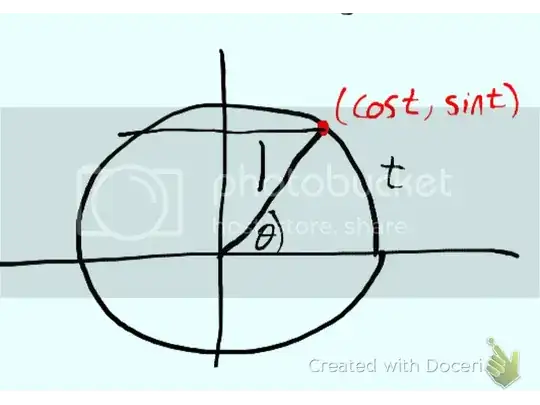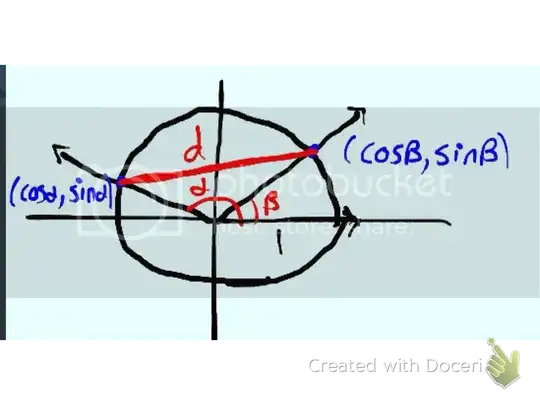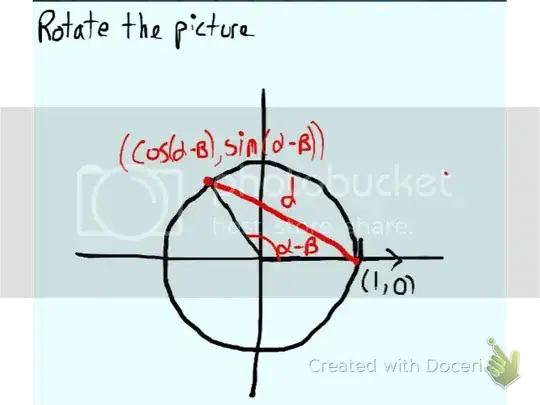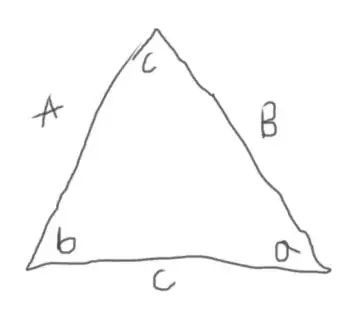I've read somewhere that the sine and cosine functions can be fully described by this theorem:
- $\sin(0) = 0, \cos(0) = 1$
- $\sin(a-b) = \sin(a)\cos(b) - \sin(b)\cos(a)$
- $\cos(a-b) = \cos(a)\cos(b) + \sin(a)\sin(b)$
- There is na $r>0$ such that: $$0<\sin(x)<x<\tan(x), x \in(0, r), \tan(x) = \frac{\sin(x)}{\cos(x)} $$
With this theorem, we can prove things like:
$\sin^2(x) + \cos^2(x) = 1$
by doing$\cos(a-a) = \cos(a)\cos(a) + \sin(a)\sin(a)$$\sin(-x) = -\sin(x)$
by doing$\sin(0-x) = \sin(0)\cos(x) - \sin(x)\cos(0)$- $\cos(a+b) = \cos(a)\cos(b) - \sin(a)\sin(b)$
by doing$\cos(a-(-b)) = \cos(a)\cos(-b) + \sin(a)\sin(-b)$
- $\sin(a+b) = \sin(a)\cos(b)+\sin(b)\cos(a)$
$\sin(a-(-b)) = \sin(a)\cos(-b) - \sin(-b)\cos(a)$by doing
And other trigonometric identities that also follows from what I've already done.
The problem is that there are many definitions for the sine and cosine function. Let's begin by the classical definition:
Classical Definition
The sine function is defined as the ratio between the opposite side of the angle, and the hipotenuse of this right triangle.
The cosine function is defined as the ratio between the adjacent side of the angle, and the hipotenuse of this right triangle.
The tangent function is defined as the ratio between the sine function and the cosine function (with $\cos (x) \neq 0)$
The other trigonometric identities can be proven geometrically for an angle less than or equal $\frac{\pi}{2}rad$ because it's a right triangle. So, we can't prove $\sin(a-b)$ geometrically and then prove $\sin(a+b)$ analytically like I did, because we assumed a negative $b$, something that's not defined geometrically in the right triangle.
The identity $\sin^2(x) + \cos^2(x) = 1$ can be proven with a simple pythagorean theorem in a triangle with hypotenuse 1.
The formulas for the sum and difference of sines and cosines can be proven geometrically like in this images I found in this answer:
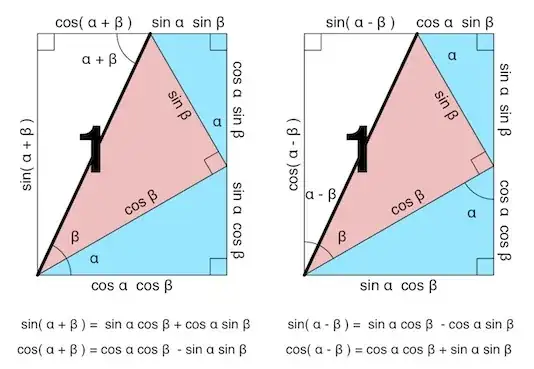
Unit circle definition
Imagine a circle centered at the origin of the cartesian plane, then:
The sine function for an $x \in R, x>0$ can be defined as the $y$ position of point of the circle where the angle stops if we travel anti-clockwise inside the circle's line.
The cosine for an $x \in R, x>0$ function can be defined as the $x$ position of point of the circle where the angle stops if we travel anti-clockwise inside the circle's line.
We can make the same definition for negative angles, so for an $x \in R, x<0$ the same holds, but we're know travelling clockwise.
The tangent function is defined as the ratio between the sine function and the cosine function (with $\cos (x) \neq 0)$
Then, we can define these functions for all real numbers, since when we travel $2\pi$ we get back to the initial point. So we defined sine and cosine as periodic functions.
Open question: How do I prove, with the unit circle periodic definition and without being circular, the $\sin(a-b)$ and $\cos(a-b)$ formulas? (same for $\sin(a+b)$ and $\cos(a+b)$.
Taylor Series definition
$$\sin x = \sum^{\infty}_{n=0} \frac{(-1)^n}{(2n+1)!} x^{2n+1}$$ $$\cos x = \sum^{\infty}_{n=0} \frac{(-1)^n}{(2n)!} x^{2n}$$ $$\tan x = \sum^{\infty}_{n=1} \frac{B_{2n} (-4)^n (1-4^n)}{(2n)!} x^{2n-1}$$
Here, in the same question, there's an analytic proof of the trigonometric identites, for these sums.
What's the best definition for calculus?
Well, in calculus we use trigonometric functions a LOT: in integral substitutions, in series, taylor series (like the ones I showed now), derivatives, convergence tests (like the Euler onde in the basel problem) and other things...
All the definitions I see, are kinda circular or not rigorous enough to make me feel good taking some derivatives or integral substitution, because I always care about the domain of these things. So I want to define it very nicely and be able to use all the trigonometric identities.
I've seen many geometrical proofs of $\sin(a-b)$, $\sin(a+b)$, $\cos(a-b)$, $\cos(a+b)$ using a right triangle and then suddenly the person starts using this formula for all real numbers. I need a complete definition of the trigonometric functions that works periodically and for all reals. The taylor series definition seems good but they're generated using trigonometric identities that are not yet proven (assuming this definition).
ps: I know that I used some primitive words in some definitions, like 'travel' so I let them in emphasis, but I hope you guys understand. And sorry by the long post, but I needed to do it, because I've never seen a complete definition in any book. Thanks.
